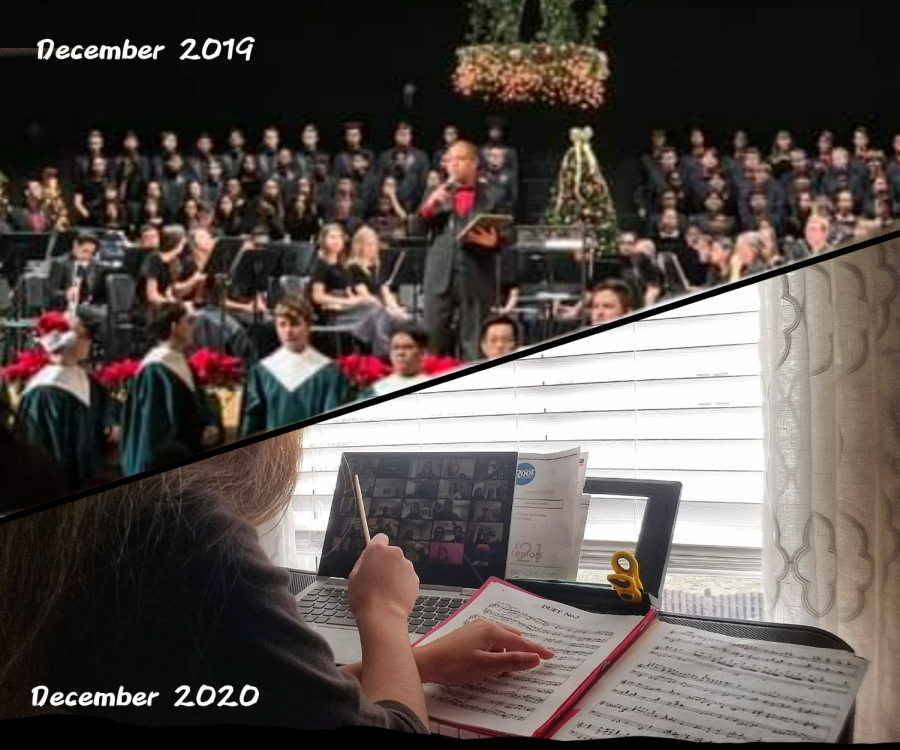Pandemic ponderings part three: East Side News investigates behind-the-scenes roles of staff
Memories of grand performances and connecting with one another emerge from the back of our minds as December rolls around. However stark the difference between playing in-person is in comparison to performing virtually, musicians continue to share their music with others.
East Side News investigates how daily life during the pandemic has changed not only for students, but staff as well. The writers and editors will interview various staff members about how their educational roles have changed with e-learning.
This segment features Music Educator Justin Koszarek.
What is the main difference between teaching music performance online and in-person?
Music performance often is an ensemble based entity, especially in a high school curriculum where we’re focused on group dynamic and collective elements. With the current situation, we are focused more on individualistic elements. How do you sound? How are you playing your part? And we are not able, as a group, to put those parts together collectively as we’d normally would in a real classroom environment. Though we are working to put them together in a pseudo-ensemble by taking recordings and compiling them into a performance.
Speaking of virtual performances, what struggles do you have in creating one? Describe the process behind creating a virtual performance.
With a virtual environment, the latency problem itself produces a delay that sounds like an echo at best or worst – a jumbled mess… [Instead], you will upload your recording to a smart music platform, Google Classroom, or Flipgrid, and you do that on your own time. The computer clock is synced to your recording time, so when I download it, I download it as if I was in the room right next to you. But we can’t do that in real time, so we have to do that on delayed time. Which is why we use a server system to catalog those recordings: Google Classroom being one, Flipgrid, and in our case, Smartmusic. We save those recordings… and then we just download it and compile those recordings on our own time.
What do you plan on doing with those audio recordings?
Sending them out to our parents, guardians, students, staff, and making that our virtual concert.
What do you miss about teaching in-person?
The free conversation that happens. There’s obviously a limit to too much conversation, but right now we’re on the side of no conversation very often. My class has gotten very good at using the chat function. For Symphonic Band, we have side conversations flowing in the chat conversation at the early parts of our class before we really dive into the material for the day. … It’s very similar to how band is in a normal world, and we try to keep that … normalcy happening through the chat function. But the fact that I don’t have that engagement with the students all the time isn’t the number one thing for me, it’s more the engagement with students on a personal level.
How do you think remote learning has affected a student’s musicality?
Well, as part of my last unit, we did a reflection at the end of the unit. I asked students basically this very question: How did this process go? What did you learn from doing this recording project? I was surprised by the number of students that felt that they did better in an individualized environment than they thought they would… Quite a few of the students said, “You know what, I think I’m a better player having spent all this time by myself and have improved myself that way.” Conversely, other people are still working through how to play by themselves in their room and work through those things without that feedback for growth because that feedback for growth is usually through the director.”
In practicing a piece, how do you know what advice to tell students without hearing how they’re doing?
A lot of it is studying the piece ahead of time. Knowing what likely technique issues are going to occur is part of my training as a director… I need to just prepare ahead of time to give my comments, and that’s something I’ve been trying to do more as a director these last couple years anyway. Instead of [waiting] for you to play, I’m working actively to say, “You know what, I know, as a director, that you’re probably going to make these mistakes.” So I’m going to tell you before you make them what you should worry about and how to improve without you making the mistakes in the first place. … If I can stop it before it happens, then you’ve never made the mistake.
What upcoming pieces do you have planned?
I’m currently working on one project for Symphonic Band, and I’ll be working on a project for percussion ensemble by the end of this semester. Same project Mr. Lesniak did for Hope for America. We’re just doing different pieces. The first project I did was that I had students do that project. They recorded themselves and then sent [that recording] to their partner and then their partner had to compile that. And then the partner had to produce the recording of a duet, and each member of the team did that.
Back in October, the band made a recording for the piece “Hope for America” as requested by the University of Illinois for a possible virtual performance. What happened to those recordings?
Nothing happened with it, it fell through. The plans didn’t work because of a variety of factors at the University of Illinois, so we were doing our work in case they did ask. They never asked, so it stopped with us and that’s about it.
Are there plans for a live performance?
At this point, we’re still under the guidance of Governor Pritzker and the tier 3 version that we’re in here in Will County… Whatever plans we have in place are only at the mercy of the school, the school district, the county, and the state.
What do you hope for students to accomplish this year?
Academically speaking, my hopes are that we continue to have an appreciation for and continue to learn about music. On a personal and social emotional level is that we maintain positive growth when possible and acknowledge that not every day is going to be great, but finding ways to get through those days is going to be super paramount.
Greetings, tis I, a staff writer on East Side News. I'm apparently a senior now and one step closer to more responsibility. This will be my second and...


